The science is solid, and the risk is real – refillable bulk dispensers are public health risks!
When you wash your hands, you expect them to be clean afterwards. Unfortunately, there is a common style of hand soap dispenser that has a high potential to leave your hands germier than before you started. At GOJO, we refer to this style of dispenser as a “refillable bulk” soap dispenser. Instead of having a sealed refill inside the dispenser that gets swapped out when it’s empty, this style of dispenser has an easy opening that someone pours soap into (for example, a hinged lid with a large bottle of soap to top it off – see picture). 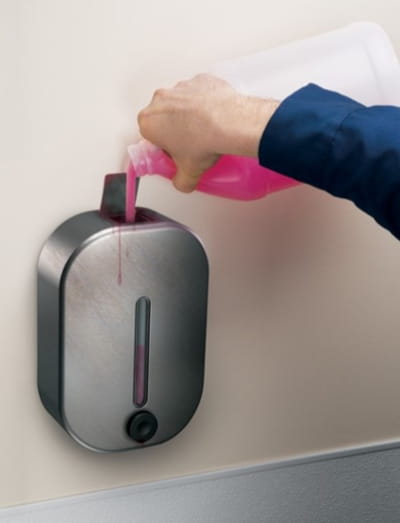 You’ve probably seen them in your daily outings – in public restrooms at rest stops, restaurants, and even schools. There are many different designs, but all have the same inherent risks.
You’ve probably seen them in your daily outings – in public restrooms at rest stops, restaurants, and even schools. There are many different designs, but all have the same inherent risks.
This style of dispenser has been around for decades. GOJO began studying the quality and public health risks of them, including sponsoring independent third-party research on these systems, in the early 2000s. Unfortunately, these dispensers are still in use because they are often sold as a lower-cost option up front and there is a lack of awareness of the inherent risks that come with these dispensers. These dispensing systems have a fundamental design flaw – they use the same container and nozzle indefinitely for the life of the dispenser. This, plus the mixing of multiple soap products, creates public health and safety risks. There are also longer-term costs to consider because they are extremely labor-intensive to maintain properly.
What are the health and safety risks?
Refillable soap dispensers have been a known public health and safety risk for decades. The CDC (in 2002)1 and the WHO (in 2009)2 recognized the bacterial contamination risk of “topping off” refillable bulk soap dispensers based on the body of evidence and have issued guidelines against it. Because of this, healthcare settings do not use these systems, but they unfortunately are still present in many businesses.
- CDC guidance includes: “Selection of hand-hygiene agents … Do not add soap to a partially empty soap dispenser. This practice of ‘topping off’ dispensers can lead to bacterial contamination of soap (IA).” (Page 33 Guideline for Hand Hygiene in Health-Care Settings)1
- WHO guidance includes: “When selecting hand hygiene products: … Do not add soap (IA) or alcohol-based formulations (II) to a partially empty soap dispenser. If soap dispensers are reused, follow recommended procedures for cleansing.” (Page 153 of WHO Guideline on Hand Hygiene in Health Care)2
FACT: All soap can be contaminated if it is poured into a bulk soap dispenser – even antibacterial soap.
Contamination: There are many inherent risks in the style of these systems – a major one is contamination because:
- Every time the lid is opened for refilling, germs can be introduced into the reservoir (where the product sits), which can cause bacteria to grow inside the dispenser. Contaminants are introduced by:
- unclean restroom attendant hands (for example, if they just cleaned the toilets)
- airborne germs (like fecal bacteria or those that come from coughing or sneezing)
- foreign objects (like flies, dust, and plastic parts)
- diluting soap with water
- Leaving soap in the same dispenser over long periods of time, without regularly and thoroughly cleaning the dispenser, causes an increased risk of biofilms developing (more on that below as this is a very serious problem).
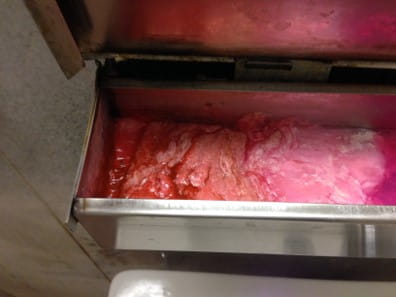
- The practice of topping off the soap, often with different brands, can impact the performance of the soap and cause unknown reactions of the preservatives present in soap, sometimes negating each other. It also often leads to phase separation (see pictures) – 2 different soap products, even of the same color, are usually not mixable.
- Soap is dispensed from a permanent nozzle that’s rarely cleaned, creating another possible contamination point.
- The easily opened dispenser can be subject to vandalism, so a person with bad intentions can deliberately contaminate the soap (which we have often seen, unfortunately, e.g., by students in schools).
FACT: 1 in 4 refillable bulk soap dispensers are contaminated with unsafe levels of bacteria,3 leaving hands with up to 25 times more germs after washing than before4 (as pictured below).
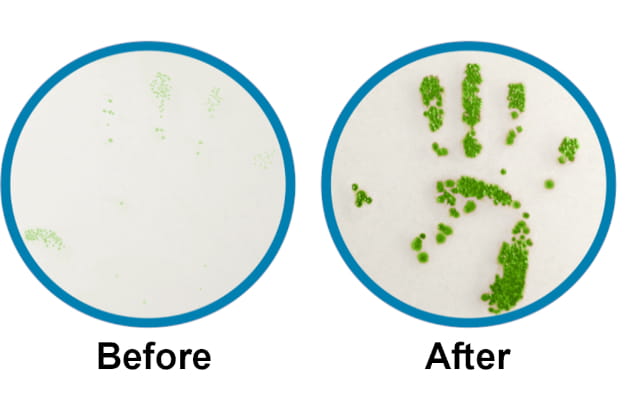
Biofilms: A biofilm forms when groups of bacteria adhere to surfaces in moist environments. They are extremely difficult to wash off or kill and have been studied for many decades.5 Because the biofilm is formed on the inside of the dispenser, it leads to bacterial contamination of any new soap added to the dispenser. (Pictured: Stereoscope image of inner dispensing tube of a plastic counter-mounted dispenser coated with unknown brown substance.) A study on biofilms present in soap dispensers found that:6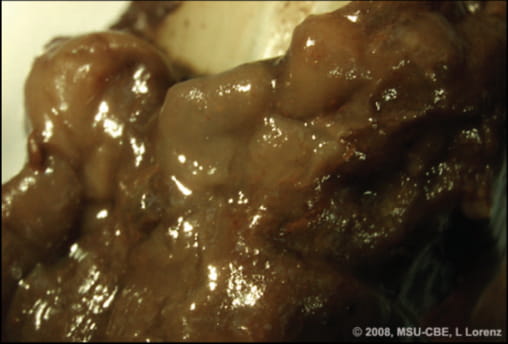
- Once dispensers are contaminated with biofilm, even cleaning and soaking in bleach has been proven ineffective, as biofilms are highly resistant.
- It takes only a tiny number of remaining bacteria from the biofilm community to recontaminate the soap and dispenser. Recontamination occurs rapidly – within two weeks.
- Contaminants can be present even when not obvious or visible (that’s why we call them “microorganisms” – you need a microscope to see them).
- Biofilms can be found in bulk dispensers made of any materials (plastic, stainless steel, etc.).
FACT: Once a biofilm grows inside the dispenser, the only way to eliminate the contamination with confidence is to replace the dispenser.
What’s the true cost of a refillable bulk dispensing system?
Beyond the “hard” costs of purchasing the bulk dispensers and bottles of bulk soap (which may have a lower up-front price tag), and installation, there are several “soft” costs to these refillable dispensing systems to consider, given the many maintenance issues with these systems. These are extra “hidden” costs that businesses aren’t expecting when installing these systems, including:
- These systems are very labor-intensive – especially if you stick to the manufacturer’s recommended cleaning schedule, which recommends regular sanitizing, some specifying monthly.
- Expecting custodians to regularly remove and soak the nozzle and flush the soap reservoir of every bulk dispenser that is bolted to the restroom walls in their facilities is unrealistic, given the other duties they have. Even if you’re able to maintain this intensive regular maintenance, studies show it often doesn’t eliminate the biofilm and pathogen contamination risk.6
- It can be costly to regularly swap out dispensers that are contaminated with biofilms or replace parts that break from wear and tear.
- The permanent pump and nozzle often wear out or break and need to be replaced (this is an added cost, plus there will be downtime while the parts are ordered, stocked, and replaced).
In addition to the time required to regularly clean these dispensers, 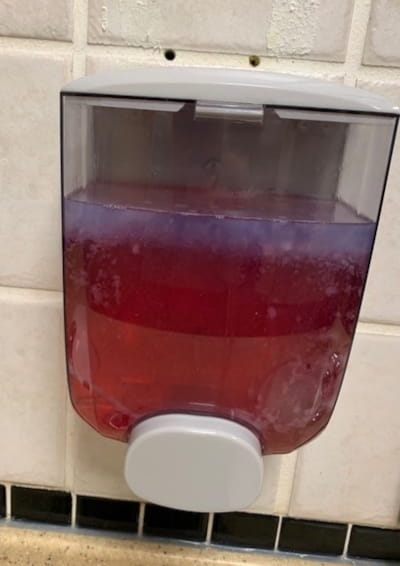 other maintenance issues include:
other maintenance issues include:
- Time and effort from pouring soap and cleaning up spills, drips, and stains.
- Dripping can cause sink and counter stains – plus, the risk of dripping increases as the nozzle ages.
- Some counter-mount systems must be refilled under the sink, so maintenance employees must remove heavy ADA-compliant access panels under the sink each time they need to refill the dispenser. This takes extra time and leads to safety concerns.
- Permanent nozzles clog easily, causing “soap’s out” complaints.
FACT: It takes only a few seconds to switch out a refill cartridge versus the many seconds it takes to carefully pour in more soap to top off a bulk dispenser (and then cleaning up the spills).
What is the impact on a facility’s image?
Providing hand soap and sanitizer is an essential part of creating a clean, high-quality atmosphere in your facility. But an inoperable or gross-looking dispenser can leave a customer with a poor impression of the facility or business they visit. If a customer thinks you’re cutting corners on cleanliness, they may wonder what else you’re cutting corners on. In foodservice, if a customer or inspector sees soap with visibly distinct layers or a filthy dispenser with items floating or growing inside it, they may wonder if the establishment prioritizes food safety – particularly if it is a bathroom that employees also use.7
Caution on bulk hand sanitizer dispensers
Unfortunately, during the pandemic, this practice of refilling dispensers jumped to hand sanitizer dispensers due to supply constraints in 2020. Read our blog posts for the other unique risks in using refillable systems with federally regulated (over-the-counter drugs) alcohol-based hand sanitizers:
Sealed refills eliminate the risks
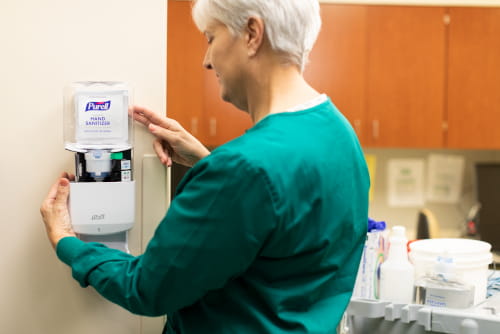
Sealed refills are easily snapped into place inside the dispenser, eliminating contamination risks and keeping the dispensing system clean, making maintenance easier, and giving your facility a cleaner, more professional look.
- In a sealed system, the soap refill is never opened, so the soap is never exposed to the environment and potential contaminants.
- Changing a refill is very simple and takes seconds.
- Foam soap refills can last longer than lotion soaps, cutting back on the frequency of refills.
- Lockable dispensers and proprietary refills deter theft and discourage tampering.
- Newer systems also feature large sight windows or exposed refills and controlled collapse bottles so it’s easier for maintenance to see at a glance when a refill is necessary. This also helps eliminate “soap’s out” complaints.
Make the switch
GOJO encourages customers to transition from refillable bulk soap dispensers to SANITARY SEALED™ dispensing systems. We introduced GOJO SANITARY SEALED™ refills in 1983. GOJO offers a full line of liquid soaps and antiseptic product dispensing systems with SANITARY SEALED™ refills.
PURELL® dispensing systems show guests and customers you care while providing the reliability and ease of maintenance to keep your facility running smoothly. For more information, visit the Dispensers page on GOJO.com.
Businesses interested in learning about PURELL® products can contact their GOJO distributor, click here to schedule a meeting with our representatives, or find a distributor now.